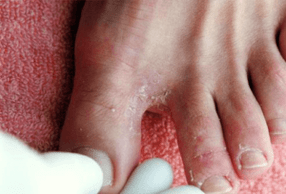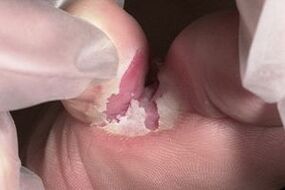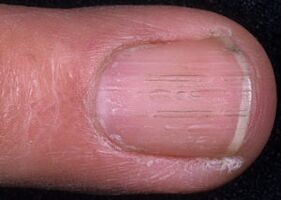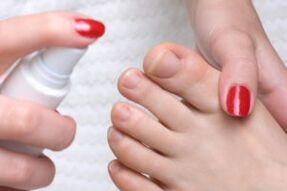Foot fungus is a skin disease that manifests itself in the active growth of certain types of fungi in the epidermis. Today, both the elderly and children with weakened immune systems are susceptible to this disease. The signs of the fungus on the feet depend on the type of pathogen in the infectious process and the volume of the foot and nail plate involved, and there are some differences at different stages, indicating the progression of the infection. You need to know how to recognize the fungus on your feet, allowing you to start treatment in time and stop its further development.

Symptoms of the disease
The main site of fungal growth on the feet is most often the area between the toes. This pathology is accompanied by the appearance of symptoms such as burning, severe itching and redness of the epidermis. In addition, one can observe cracked and peeling skin as well as the formation of blisters on the legs and increased dryness of the skin.
The same fungal symptoms can occur on the soles of the feet and are accompanied by excessive keratinization of the skin. The insidiousness of such a disease lies in the fact that during its course, difficult-to-treat fungi can form on the legs and the wounds themselves are in a state of superinfection.
How can the foot fungus be recognized and what symptoms may indicate the onset of the disease? The first signs of the disease are the appearance of small scales, i. e. various types of exfoliation, from small pityriasis to large lamellae. Different types of fungi provoke the development of the disease, but they are all characterized by the same symptoms:

- In the early stages of its development, the pathology progresses without the appearance of pronounced symptoms. Above all, the interdigital folds are affected, and most commonly between the third and fourth fingers.
- As the fungal disease progresses, the sides of the feet are affected, gradually spreading to the ankles.
- When a fungal infection of the foot occurs, the skin noticeably thickens, cracks, and begins to glow.
- The skin becomes too dry and very itchy. In addition, the epidermis becomes very red and the affected areas become inflamed.
- Patients complain of pain and a burning sensation in their legs.
- As the disease progresses to a neglected form, blisters appear on the skin. When opened, the affected areas of the skin are very moist and soft.
There are several forms of foot fungus, and each is associated with the development of certain symptoms.
Forms of pathology
Experts identify the following types of fungi that can affect the skin of the feet:
- interdigital;
- hyperkeratotic (moccasin);
- dehydrotic.
The most common form of interdigital fungus on the foot is the interdigital, which is characterized by the appearance of certain signs:
- most often, the area of the fourth and fifth toes becomes the site of localization of this form of the fungus.
- as the disease progresses, the skin acquires a characteristic scaly appearance and may crack severely;
- Between 3, 4 and 5, a crying crack or funnel is formed, surrounded by white or green scales of dried skin.

Interdigital fungal skin lesions can be dry or wet. In case a wet interdigital fungus is detected, the skin appears swollen. Exfoliation and detachment can be observed in dry lesions of the epidermis.
The first sign of a moccasin-like foot fungus is pain, the manifestation of which is observed in the foot. As the pathology progresses, a gradual thickening of the skin on the sole can be observed, causing the formation of cracks.
This form of fungal disease of the legs is the most severe and neglected but easily recognizable. Fungal disease can manifest itself in the defeat of the nail plates, in which case they develop a characteristic thickening, are prone to disintegration, and may even fall out completely.
The vesicular form of the fungus is characterized by the formation of vesicles with a clear liquid inside. Such blisters gradually ripen, become cloudy, and open, causing erosion of various magnitudes. The main location of the bubbles will be in the area closer to the toes of the sole, but rashes may occur all over the moccasin.
The vesicular form of the fungal disease is quite rare but much easier to treat. This is due to the fact that the blisters become the site of localization of the pathogen, i. e. they do not penetrate the deeper layers of the skin. If a viral or fungal infection is associated with a vesicular fungal disease, severe skin lesions can be observed and treatment becomes difficult.
Specialists distinguish the deleted form of the fungus on the legs in which all symptoms are blurred. Diagnosing such a pathology is quite problematic because the affected skin looks like a simple, disordered foot. In a patient with such foot fungus, the symptoms are yellowing of the nails and peeling of the foot, but they are so mild that the patient does not pay attention to them.
The deleted form of the fungus moves in waves, meaning it gets worse during the hot season and almost completely disappears in winter. In case of weakening of the immune system, a sharp worsening of the disease is observed, which causes difficulties in the treatment of the fungus.
How is onychomycosis recognized?
The signs of nail fungus can vary significantly at different stages, indicating the progression of the infection. How does nail fungus start and what signs should I pay attention to?

- In the first stage, the lesion has no characteristic symptoms, with barely noticeable streaks and spots appearing on the nail. In case you ignore the first signs of the disease and start the fungus, it is possible for pus to accumulate in the area of the periungual plates. The result of such an abnormal process is gangrene or amputation of the lower extremities.
- With the second degree of fungal disease, the natural light on the nails disappears. Gradually, the color of the nail changes and white and brown streaks form on it. Deformation of the upper and lateral parts of the nail is possible. The advanced stage of bacterial nail damage is characterized by increased fragility, delamination, and inflammation of the cuticle. The pathology progresses and spreads to other nails and feet.
- In the third stage of onychomycosis, the nail turns yellow or dirty brown. Plus, it gets too loose, thickens, and lags behind the nail bed. Often when wearing shoes, severe pain begins and the itching of the skin simply becomes unbearable.
There are several types of fungal infections of the toenails, each of which causes certain symptoms to appear.
- Hypertrophic onychomycosis is associated with thickening and yellowing of the nail. The nail is crumbling well, with a thickened epithelium underneath.
- Atrophic onychomycosis causes thinning and destruction of the nail, with keratinized skin underneath.
- Onychomycosis, which is affected by molds, often does not develop as a stand-alone disease but underlies other pathologies.
Nails can be painted yellow, brown, green or black. Often, a complication develops in the form of inflammation of the periungual bed with the release of pus.
Prevention of pathology

With the normal functioning of the immune system, the fungus is unlikely to start developing after infection because the body is able to cope with it. In case the fungal infection continues to affect the feet and nails, effective treatment should be given. The sooner the fight against such a pathology begins, the greater the patient’s chances of complete recovery.
Fighting foot fungus is a rather laborious process, making it easier to prevent the disease from developing. To do this, the following precautions must be taken:
- keep your feet dry;
- do not wear the shoes of others;
- choose socks made of cotton fabric;
- Don't run barefoot on the beach.
When the first signs of the fungus appear on your feet, consult a specialist. It is important to identify the pathology at the beginning of development and prevent further progression, which helps to avoid many complications. In order to understand how to identify the fungus on your feet, you should consult a dermatologist.

























